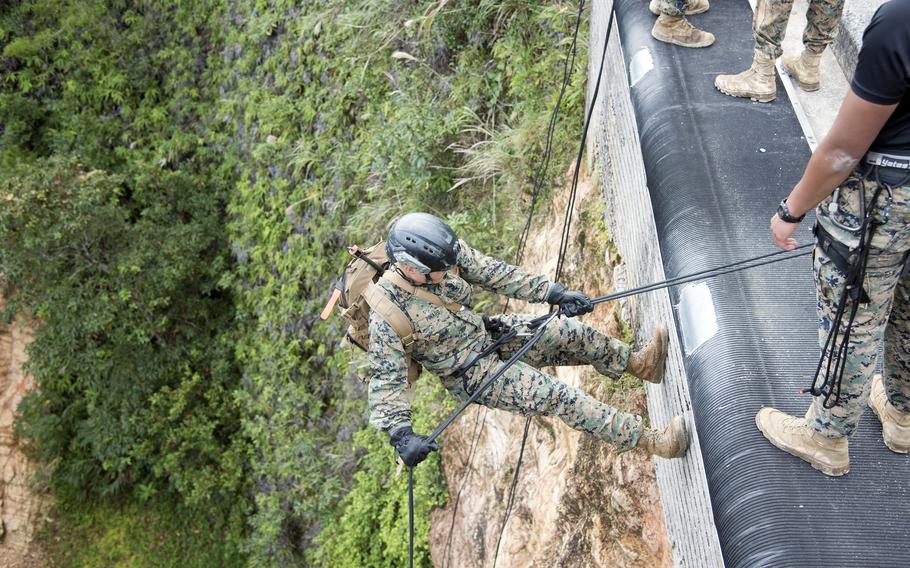
A Marine rappels down a 70-foot cliff at the Jungle Warfare Training Center on Camp Gonsalves, Okinawa, Dec. 11, 2024. (Brian McElhiney/Stars and Stripes)
CAMP GONSALVES, Okinawa — About 40 Marines took turns Wednesday descending a 45-foot cliff — a hasty rappelling obstacle — part of a weeklong course designed to teach them and other service members how to fight and survive in a jungle environment.
Instructors at the cliff bottom — “jungle leaders” — called out encouragement, shouting out when to crawl, walk and run.
“Right now, because it’s the beginning of the day, they’re just going through without any equipment on,” Gunnery Sgt. Caleb Holsinger, the basic jungle skills course chief, said during a media tour of the center. “But later on in the day you’ll see rifles and packs and stuff like that going down both of these.”
The potential for conflict in the Indo-Pacific has heightened the importance of jungle warfare training in recent years, according to Lt. Col. Kelly Candies, director of the training center.
For example, while no Marine is required to take jungle warfare training, the recently created 12th Marine Littoral Regiment based at Camp Hansen is considering the course.
Littoral regiments are designed as smaller, mobile units inserted within enemy missile range to seize and hold key Pacific islands and deny enemy vessels access to surrounding areas, a key tenet of the Marine Corps’ island-fighting doctrine in its Force Design plan.
At the rappelling site, the 45-degree hasty rappel seemed a bit less daunting than the nearly vertical, 70-foot-high main rappelling cliff.
The hardest part for Marines rappelling from the 70-foot cliff is just “getting off that platform,” said Cpl. Irving Gomez, a jungle leader.
“We do brief them on, when they first originally get here, how tall the cliff is just to get them mentally prepared,” he said, looking down from the cliff top. “But we don’t have a smaller one. They see a good and bad demo, and that would be their view of seeing and getting confident and ready for the rappel.”
The Jungle Warfare Training Center — the only one of its kind in the Department of Defense — was established in 1958 across 17,000 acres of mountains and jungle in the north of Okinawa. It’s open to Marines, sailors, soldiers and airmen, as well as other NATO forces and Japanese troops, Holsinger said.
The center offers four courses: basic jungle skills; a five-week jungle leaders’ course that qualifies service members to lead other troops through jungle terrain; a jungle medicine course; and a jungle communications course. Units can also use the center to do their own training, Holsinger said.
About 7,000 to 10,000 troops come through the center each year, he said.
About 160 Marines from several units signed up for the basic jungle skills course Wednesday.
They practiced Tuesday and on Wednesday at several stations: cliff rappelling; survival skills such as fire-making, finding water and building shelters; patrolling; and combat casualty care. They were scheduled to be tested Thursday for their certifications, Holsinger said.
The course concludes Friday with a nearly four-mile, 18-obstacle jungle course.
“The importance is that we are prepared to do our job in any environment,” Candies said. “Being here helps build confidence with our allies and partners.”